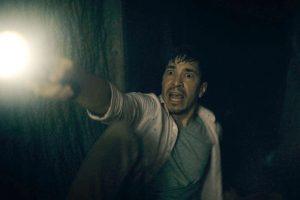#5. Barbarian

There’s something to be said regarding the impact low-budget horror movies have had on the wider cultural pathos. From “Night of The Living Dead” in the 1950s to “Texas Chainsaw Massacre” in the 1970s, it’s undeniable that artists working in blood can get major results with little resources. Unlike any other genre, a horror film can succeed with no major stars or studio backing. If a picture achieves its goal of being scary, audiences will find it.
Following in the footsteps of other great haunted house flicks, “Barbarian” is a disturbing and thoughtful work not intended for the squeamish. The unique storytelling structure and continuous twists and turns keep you on the edge of your seat. “Barbarian” established director Zach Cregger, who you may know from his work as a comedian, as a filmmaker to watch. In a deeply twisted way, Cregger finds comedy within the most revolting subjects, creating something that is simultaneously entertaining and challenging.
What promises to be an enjoyable horror experience exceeds all expectations through continuous character, location and tonal shifts. From gnarly scream-inducing scares to non-stop escalation, “Barbarian” is one of 2022’s true surprises. Be warned: you may want to watch this with the lights on.
#4. Everything Everywhere All at Once

No film captured the hearts of audiences in 2022 quite like “Everything Everywhere All at Once.” The undefinable science-fiction adventure piece, from directing duo Daniels, is creativity on full blast. From classic kung fu action sequences to a Pixar parody, each frame is bursting with passion for film history. It’s no surprise that “Everything Everywhere All at Once” has connected with audiences. It has even gone as far as to gross over one hundred million dollars at the box office, a great feat for an independent film.
Utilizing sensational performances from Michelle Yeoh (“Crouching Tiger, Hidden Dragon”) and Ke Huy Quan (“The Goonies”), Daniel Kwan and Daniel Scheinert craft the story of a Chinese-American family attempting to navigate taxes and relationship dynamics. Pushing visual storytelling to its limits, Daniels hijacked a saturated market of films that embrace a possible “multiverse” and extend the concept into something with deep emotional resonance. Absurdist, grand and intimate, it’s hard to leave “Everything Everywhere All at Once” without a smile on your face and tears in your eyes.
#3. Decision To Leave

With “Decision To Leave,” the great Korean filmmaker Park Chan-Wook proves his ability to provoke, without the visceral violence and provocative nature of his previous works. The film follows a detective investigating a man’s strange death who develops an attraction to the dead man’s mystifying wife.
The name behind modern masterpieces like “Oldboy” and “The Handmaiden” creates a new work every bit as thrilling and suspenseful. Crafted with remarkable attention to detail, Park’s erotic murder mystery can be as confusing as it is complex. Unless the viewer is willing to lend themselves to the hands of a master, the sheer pace may provide whiplash for modern audiences.
Simply put, this is a picture not to be watched and forgotten.Park Chan-Wook, Asian cinema’s great provocateur, takes immense influence from Alfred Hitchcock’s “Vertigo” and recontextualizes it for a modern Korean landscape. Split screens, Point-of-View shots (POVs), whip pans; every technical aspect controls the viewer’s attention. “Decision to Leave” follows in the footsteps of past films noir. It’s as cynical and romantic as Billy Wilder’s “Double Indemnity,” with the slick stylization of Brian DePalma’s “Blow-Out.” “Decision to Leave” is a film to be rewatched and studied for years to come.
#2. All the Beauty and the Bloodshed

I was 13 years old when I first discovered the photography of Nan Goldin. At the time, I had never seen anything like it. Her raw compositions and unflinching subjects lead to work truly transportative to another time and world. The first Goldin image I ever saw features two drag queens in a taxi staring at the camera, the photograph capturing two marginalized individuals at the height of the AIDS epidemic. At the time, I had no idea how far Goldin’s work extended, nor her influence and story.
“All the Beauty and the Bloodshed,” the new film from trailblazing documentarian Laura Poitras, follows Nan Goldin’s life as an artist and her battle against the opioid-slinging Sackler family. Open and intimate, with connecting dual narratives, “All the Beauty and the Bloodshed” is a showcase of two artists and their immense power.
Poitras finds something uniquely profound in Goldin, who’s story is just as tragic as it is fascinating. When she was only 11, Goldin’s sister committed suicide, leaving her with a fractured home life. This documentary focuses on sexual repression, censorship and the Sackler family’s role in the opioid epidemic as well as the art world. It’s a profound, touching and all too necessary work that equally informs and inspires.
#1. RRR

When I opened Netflix last summer to watch the highest-budget Indian film ever made, I had no idea I would soon fall in love. “RRR” is the type of ambitious action epic we haven’t seen since James Cameron’s “Avatar,” presenting an unparalleled grandeur.
Director S. S. Rajamouli has given the world a jaw-dropping, anti-colonizer masterpiece of maximalist action, intricate set pieces and over the top computer-generated imagery (CGI). The Telugu-language picture takes place in the 1920s, and though it misses some historical context, we are presented with a fantastical view of revolution amidst British colonial rule.
Rajamouli cites William Wyler’s “Ben-Hur” and Quentin Tarantino’s “Django Unchained” as some of his favorite works, and one can easily see the grand scale of “Ben-Hur” drenched in the violent alternate history of Tarantino in Rajamouli’s latest work. Amongst action set pieces that put American studio filmmaking to shame, “RRR” is a powerful story of resilience, rebellion and comradery.
If you are fortunate enough to live near a theater screening “RRR” (as part of its limited theatrical run in America) you would be doing yourself a disservice to not witness its greatness. With an audience, every moment feels as though you are attending a World Cup game. Rajamouli takes a tragic moment in India’s history and paints it lavishly, without sacrificing the seriousness of the subject.





































